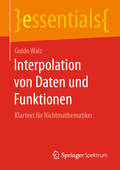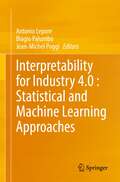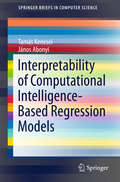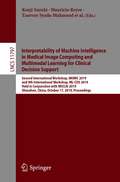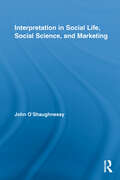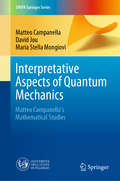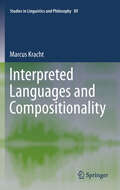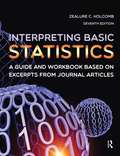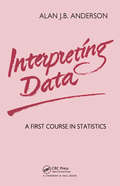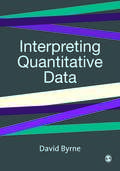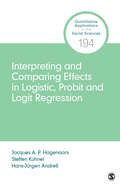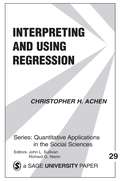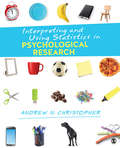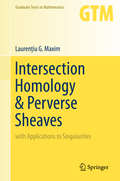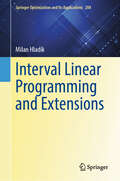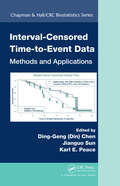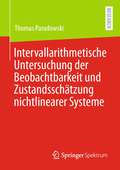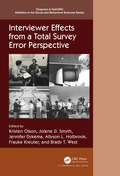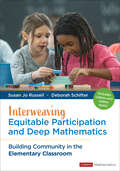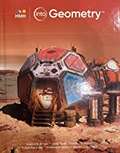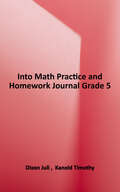- Table View
- List View
Interpolation von Daten und Funktionen: Klartext für Nichtmathematiker (essentials)
by Guido WalzDieses essential vermittelt in leicht zugänglicher Sprache verschiedene Techniken zur Interpolation von Daten und Funktionen. Der Fokus liegt dabei zunächst auf der Interpolation mit Polynomen, also ganzrationalen Funktionen, da diese in der Lage sind, jede beliebige Konstellation von Daten eindeutig zu interpolieren. Des Weiteren soll die Möglichkeit aufgezeigt werden, nicht nur die Werte einer Funktion, sondern auch die ihrer Ableitung – also die Steigungen in den einzelnen Punkten – durch Interpolation mit Polynomen darzustellen. Weisen die vorgelegten Daten ein periodisches oder exponentielles Verhalten auf, ist die Verwendung von Polynomen weniger geeignet. In diesen Fällen sollte man besser trigonometrische Summen oder Exponentialsummen verwenden. Zahlreiche Beispiele machen das essential leicht verständlich.
Interpretability for Industry 4.0 : Statistical and Machine Learning Approaches
by Jean-Michel Poggi Antonio Lepore Biagio PalumboThis volume provides readers with a compact, stimulating and multifaceted introduction to interpretability, a key issue for developing insightful statistical and machine learning approaches as well as for communicating modelling results in business and industry.Different views in the context of Industry 4.0 are offered in connection with the concepts of explainability of machine learning tools, generalizability of model outputs and sensitivity analysis. Moreover, the book explores the integration of Artificial Intelligence and robust analysis of variance for big data mining and monitoring in Additive Manufacturing, and sheds new light on interpretability via random forests and flexible generalized additive models together with related software resources and real-world examples.
Interpretability of Computational Intelligence-Based Regression Models
by Tamás Kenesei János AbonyiThe key idea of this book is that hinging hyperplanes, neural networks and support vector machines can be transformed into fuzzy models, and interpretability of the resulting rule-based systems can be ensured by special model reduction and visualization techniques. The first part of the book deals with the identification of hinging hyperplane-based regression trees. The next part deals with the validation, visualization and structural reduction of neural networks based on the transformation of the hidden layer of the network into an additive fuzzy rule base system. Finally, based on the analogy of support vector regression and fuzzy models, a three-step model reduction algorithm is proposed to get interpretable fuzzy regression models on the basis of support vector regression. The authors demonstrate real-world use of the algorithms with examples taken from process engineering, and they support the text with downloadable Matlab code. The book is suitable for researchers, graduate students and practitioners in the areas of computational intelligence and machine learning.
Interpretability of Machine Intelligence in Medical Image Computing and Multimodal Learning for Clinical Decision Support: Second International Workshop, iMIMIC 2019, and 9th International Workshop, ML-CDS 2019, Held in Conjunction with MICCAI 2019, Shenzhen, China, October 17, 2019, Proceedings (Lecture Notes in Computer Science #11797)
by Ben Glocker Kenji Suzuki Mauricio Reyes Tanveer Syeda-Mahmood Hayit Greenspan Anant Madabhushi Roland Wiest Eth Zurich Yaniv GurThis book constitutes the refereed joint proceedings of the Second International Workshop on Interpretability of Machine Intelligence in Medical Image Computing, iMIMIC 2019, and the 9th International Workshop on Multimodal Learning for Clinical Decision Support, ML-CDS 2019, held in conjunction with the 22nd International Conference on Medical Imaging and Computer-Assisted Intervention, MICCAI 2019, in Shenzhen, China, in October 2019. The 7 full papers presented at iMIMIC 2019 and the 3 full papers presented at ML-CDS 2019 were carefully reviewed and selected from 10 submissions to iMIMIC and numerous submissions to ML-CDS. The iMIMIC papers focus on introducing the challenges and opportunities related to the topic of interpretability of machine learning systems in the context of medical imaging and computer assisted intervention. The ML-CDS papers discuss machine learning on multimodal data sets for clinical decision support and treatment planning.
Interpretation in Social Life, Social Science, and Marketing (Routledge Interpretive Marketing Research)
by John O'Shaughnessy'Interpretation' is used as an umbrella for bringing together a wide range of concepts and developments in the philosophy of social science that provide the foundation for clear thinking about social phenomena. In his new book, John O’Shaughnessy familiarises the reader with the nature of interpretation and its importance in social life, decision making in social science enquiries and consumer marketing, thus offering a multidisciplinary approach to problems of bias and uncertainty. Thus, this book is novel in its outlook and comprehensive in its approach. Whereas past studies in interpretation have focused on hermeneutical methods, O’Shaughnessy goes further considering the role of interpretation in social interactions, in undertaking scientific work, in the use of statistics, in causal analysis, in consumer evaluations of products and artifacts and in interpreting problematic situations together with the corresponding biases arising from emotional happiness and the concepts employed.
Interpretative Aspects of Quantum Mechanics: Matteo Campanella's Mathematical Studies (UNIPA Springer Series)
by David Jou Matteo Campanella Maria Stella MongiovìThis book presents a selection of Prof. Matteo Campanella’s writings on the interpretative aspects of quantum mechanics and on a possible derivation of Born's rule – one of the key principles of the probabilistic interpretation of quantum mechanics – that is independent of any priori probabilistic interpretation. This topic is of fundamental interest, and as such is currently an active area of research. Starting from a natural method of defining such a state, Campanella found that it can be characterized through a partial density operator, which occurs as a consequence of the formalism and of a number of reasonable assumptions connected with the notion of a state. The book demonstrates that the density operator arises as an orbit invariant that has to be interpreted as probabilistic, and that its quantitative implementation is equivalent to Born's rule. The appendices present various mathematical details, which would have interrupted the continuity of the discussion if they had been included in the main text. For instance, they discuss baricentric coordinates, mapping between Hilbert spaces, tensor products between linear spaces, orbits of vectors of a linear space under the action of its structure group, and the class of Hilbert space as a category.
Interpreted Languages and Compositionality
by Marcus KrachtThis book argues that languages are composed of sets of 'signs', rather than 'strings'. This notion, first posited by de Saussure in the early 20th century, has for decades been neglected by linguists, particularly following Chomsky's heavy critiques of the 1950s. Yet since the emergence of formal semantics in the 1970s, the issue of compositionality has gained traction in the theoretical debate, becoming a selling point for linguistic theories. Yet the concept of 'compositionality' itself remains ill-defined, an issue this book addresses. Positioning compositionality as a cornerstone in linguistic theory, it argues that, contrary to widely held beliefs, there exist non-compositional languages, which shows that the concept of compositionality has empirical content. The author asserts that the existence of syntactic structure can flow from the fact that a compositional grammar cannot be delivered without prior agreement on the syntactic structure of the constituents.
Interpreting Basic Statistics: A Guide and Workbook Based on Excerpts from Journal Articles
by Zealure C. HolcombThis book presents brief excerpts from research journals representing a variety of fields, with an emphasis on the social and behavioral sciences. The questions that follow each excerpt allow students to practice interpreting published research results.
Interpreting Data: A First Course in Statistics
by Alan J. AndersonA grasp of the ways in which data can be collected, summarised and critically appraised is fundamental to application of the commonly used inferential techniques of statistics. By reviewing the criteria for the design of questionnaires, planned experiments and surveys so as to minimise bias and by considering research methodology in general, this book clarifies the basic requirements of data collection. This introduction to statistics emphasizes the importance of data - its collection, summary and appraisal - in the application of statistical techniques. This book will be invaluable to first- year students in statistics as well as to students from other disciplines on courses with a 'statistics module'. Non-numerated postgradates embarking on research will also find much of the content useful.
Interpreting Quantitative Data
by David ByrneHow do quantitative methods help us to acquire knowledge of the real world? What are the `do's' and `don'ts' of effective quantitative research? This refreshing and accessible book provides students with a novel and useful resource for doing quantitative research. It offers students a guide on how to: interpret the complex reality of the social world; achieve effective measurement; understand the use of official statistics; use social surveys; understand probability and quantitative reasoning; interpret measurements; apply linear modelling; understand simulation and neural nets; and integrate quantitative and qualitative modelling in the research process. Jargon-free and written with the needs of students in mind, the book will be required reading for students interested in using quantitative research methods.
Interpreting and Comparing Effects in Logistic, Probit, and Logit Regression (Quantitative Applications in the Social Sciences)
by Jacques A. Hagenaars Steffen Kuhnel Hans-Jurgen AndressLog-linear, logit and logistic regression models are the most common ways of analyzing data when (at least) the dependent variable is categorical. This volume shows how to compare coefficient estimates from regression models for categorical dependent variables in three typical research situations: (i) within one equation, (ii) between identical equations estimated in different subgroups, and (iii) between nested equations. Each of these three kinds of comparisons brings along its own particular form of comparison problems. Further, in all three areas, the precise nature of comparison problems in logistic regression depends on how the logistic regression model is looked at and how the effects of the independent variables are computed. This volume presents a practical, unified treatment of these problems, and considers the advantages and disadvantages of each approach, and when to use them, so that applied researchers can make the best choice related to their research problem. The techniques are illustrated with data from simulation experiments and from publicly available surveys. The datasets, along with Stata syntax, are available on a companion website.
Interpreting and Comparing Effects in Logistic, Probit, and Logit Regression (Quantitative Applications in the Social Sciences)
by Jacques A. Hagenaars Steffen Kuhnel Hans-Jurgen AndressLog-linear, logit and logistic regression models are the most common ways of analyzing data when (at least) the dependent variable is categorical. This volume shows how to compare coefficient estimates from regression models for categorical dependent variables in three typical research situations: (i) within one equation, (ii) between identical equations estimated in different subgroups, and (iii) between nested equations. Each of these three kinds of comparisons brings along its own particular form of comparison problems. Further, in all three areas, the precise nature of comparison problems in logistic regression depends on how the logistic regression model is looked at and how the effects of the independent variables are computed. This volume presents a practical, unified treatment of these problems, and considers the advantages and disadvantages of each approach, and when to use them, so that applied researchers can make the best choice related to their research problem. The techniques are illustrated with data from simulation experiments and from publicly available surveys. The datasets, along with Stata syntax, are available on a companion website.
Interpreting and Using Regression
by Christopher H. AchenInterpreting and Using Regression sets out the actual procedures researchers employ, places them in the framework of statistical theory, and shows how good research takes account both of statistical theory and real world demands. Achen builds a working philosophy of regression that goes well beyond the abstract, unrealistic treatment given in previous texts.
Interpreting and Using Statistics in Psychological Research
by Andrew N. ChristopherThis practical, conceptual introduction to statistical analysis by award-winning teacher Andrew N. Christopher uses published research with inherently interesting social sciences content to help students make clear connections between statistics and real life. Using a friendly, easy-to-understand presentation, Christopher walks students through the hand calculations of key statistical tools and provides step-by-step instructions on how to run the appropriate analyses for each type of statistic in SPSS and how to interpret the output. With the premise that a conceptual grasp of statistical techniques is critical for students to truly understand why they are doing what they are doing, the author avoids overly formulaic jargon and instead focuses on when and how to use statistical techniques appropriately.
Interpreting and Using Statistics in Psychological Research
by Andrew N. ChristopherThis practical, conceptual introduction to statistical analysis by award-winning teacher Andrew N. Christopher uses published research with inherently interesting social sciences content to help students make clear connections between statistics and real life. Using a friendly, easy-to-understand presentation, Christopher walks students through the hand calculations of key statistical tools and provides step-by-step instructions on how to run the appropriate analyses for each type of statistic in SPSS and how to interpret the output. With the premise that a conceptual grasp of statistical techniques is critical for students to truly understand why they are doing what they are doing, the author avoids overly formulaic jargon and instead focuses on when and how to use statistical techniques appropriately.
Intersection Homology & Perverse Sheaves: with Applications to Singularities (Graduate Texts in Mathematics #281)
by Laurenţiu G. MaximThis textbook provides a gentle introduction to intersection homology and perverse sheaves, where concrete examples and geometric applications motivate concepts throughout. By giving a taste of the main ideas in the field, the author welcomes new readers to this exciting area at the crossroads of topology, algebraic geometry, analysis, and differential equations. Those looking to delve further into the abstract theory will find ample references to facilitate navigation of both classic and recent literature. Beginning with an introduction to intersection homology from a geometric and topological viewpoint, the text goes on to develop the sheaf-theoretical perspective. Then algebraic geometry comes to the fore: a brief discussion of constructibility opens onto an in-depth exploration of perverse sheaves. Highlights from the following chapters include a detailed account of the proof of the Beilinson–Bernstein–Deligne–Gabber (BBDG) decomposition theorem, applications of perverse sheaves to hypersurface singularities, and a discussion of Hodge-theoretic aspects of intersection homology via Saito’s deep theory of mixed Hodge modules. An epilogue offers a succinct summary of the literature surrounding some recent applications.Intersection Homology & Perverse Sheaves is suitable for graduate students with a basic background in topology and algebraic geometry. By building context and familiarity with examples, the text offers an ideal starting point for those entering the field. This classroom-tested approach opens the door to further study and to current research.
Interval Linear Programming and Extensions (Springer Optimization and Its Applications #208)
by Milan HladíkThis book delves into the intricate world of interval programming, offering a comprehensive exploration of mathematical programming problems characterized by interval data. Interval data, often arising from uncertainties like measurement errors or estimations, are also pivotal in analyzing stability, sensitivity, and managing numerical issues. At the heart of this book is the principle of interval analysis, ensuring that all possible realizations of interval data are accounted for. Readers will uncover a wealth of knowledge as the author meticulously examines how variations in input coefficients affect optimal solutions and values in linear programming. The chapters are organized into three parts: foundational concepts of interval analysis, linear programming with interval data, and advanced extensions into multiobjective and nonlinear problems. This book invites readers to explore critical questions about stability, duality, and practical applications across diverse fields. With contributions from eminent scholars, it provides a unique blend of theoretical insights and practical case studies. Designed for both researchers and students with a basic understanding of mathematics, this book serves as an essential resource for anyone interested in mathematical programming. Whether used as a monograph or a lecture textbook, it offers clear explanations and comprehensive proofs to make complex concepts accessible. Scholars in operations research, applied mathematics, and related disciplines will find this volume invaluable for advancing their understanding of interval programming.
Interval Reachability Analysis: Bounding Trajectories of Uncertain Systems with Boxes for Control and Verification (SpringerBriefs in Electrical and Computer Engineering)
by Murat Arcak Pierre-Jean Meyer Alex DevonportThis brief presents a suite of computationally efficient methods for bounding trajectories of dynamical systems with multi-dimensional intervals, or ‘boxes’. It explains the importance of bounding trajectories for evaluating the robustness of systems in the face of parametric uncertainty, and for verification or control synthesis problems with respect to safety and reachability properties. The methods presented make use of: interval analysis; monotonicity theory; contraction theory; and data-driven techniques that sample trajectories. The methods are implemented in an accompanying open-source Toolbox for Interval Reachability Analysis. This brief provides a tutorial description of each method, focusing on the requirements and trade-offs relevant to the user, requiring only basic background on dynamical systems. The second part of the brief describes applications of interval reachability analysis. This makes the brief of interest to a wide range of academic researchers, graduate students, and practising engineers in the field of control and verification.
Interval-Censored Time-to-Event Data: Methods and Applications (Chapman & Hall/CRC Biostatistics Series)
by Jianguo Sun Karl E. Peace Ding-GengInterval-Censored Time-to-Event Data: Methods and Applications collects the most recent techniques, models, and computational tools for interval-censored time-to-event data. Top biostatisticians from academia, biopharmaceutical industries, and government agencies discuss how these advances are impacting clinical trials and biomedical research.Divid
Intervallarithmetische Untersuchung der Beobachtbarkeit und Zustandsschätzung nichtlinearer Systeme
by Thomas ParadowskiBasierend auf Methoden der Intervallarithmetik stellt Thomas Paradowski einen neuartigen Algorithmus zur Bestimmung der Beobachtbarkeit nichtlinearer zeitkontinuierlicher Systeme vor. Mittels des verwendeten Potenzreihenkalkühls werden die erforderlichen Lie-Ableitungen automatisch berechnet. Dadurch ist es möglich, nicht nur lokale Aussagen über die Beobachtbarkeit zu treffen, sondern auch globale Aussagen. Für die Fälle, in denen das nichtlineare System nicht vollständig global beobachtbar auf einem gewählten Zustandsraum ist, können jene Zustände isoliert werden, für die die Beobachtbarkeit nachweisbar ist. Ebenfalls wird eine Methode zur Zustandsschätzung von nichtlinearen Systemen mit rauschbehafteten Ausgangsmessungen präsentiert. Dabei sind entgegen anderen Methoden keine Kenntnisse zu der Art oder der maximalen Rauschamplitude erforderlich.
Interviewer Effects from a Total Survey Error Perspective (Chapman & Hall/CRC Statistics in the Social and Behavioral Sciences)
by Frauke Kreuter Jolene D. Smyth Brady T. West Allyson L. Holbrook Risten Olson Jennifer DykemaInterviewer Effects from a Total Survey Error Perspective presents a comprehensive collection of state-of-the-art research on interviewer-administered survey data collection. Interviewers play an essential role in the collection of the high-quality survey data used to learn about our society and improve the human condition. Although many surveys are conducted using self-administered modes, interviewer-administered modes continue to be optimal for surveys that require high levels of participation, include difficult-to-survey populations, and collect biophysical data. Survey interviewing is complex, multifaceted, and challenging. Interviewers are responsible for locating sampled units, contacting sampled individuals and convincing them to cooperate, asking questions on a variety of topics, collecting other kinds of data, and providing data about respondents and the interview environment. Careful attention to the methodology that underlies survey interviewing is essential for interviewer-administered data collections to succeed. In 2019, survey methodologists, survey practitioners, and survey operations specialists participated in an international workshop at the University of Nebraska-Lincoln to identify best practices for surveys employing interviewers and outline an agenda for future methodological research. This book features 23 chapters on survey interviewing by these worldwide leaders in the theory and practice of survey interviewing. Chapters include: The legacy of Dr. Charles F. Cannell’s groundbreaking research on training survey interviewers and the theory of survey interviewing Best practices for training survey interviewers Interviewer management and monitoring during data collection The complex effects of interviewers on survey nonresponse Collecting survey measures and survey paradata in different modes Designing studies to estimate and evaluate interviewer effects Best practices for analyzing interviewer effects Key gaps in the research literature, including an agenda for future methodological research Written for managers of survey interviewers, survey methodologists, and students interested in the survey data collection process, this unique reference uses the Total Survey Error framework to examine optimal approaches to survey interviewing, presenting state-of-the-art methodological research on all stages of the survey process involving interviewers. Acknowledging the important history of survey interviewing while looking to the future, this one-of-a-kind reference provides researchers and practitioners with a roadmap for maximizing data quality in interviewer-administered surveys.
Interweaving Equitable Participation and Deep Mathematics: Building Community in the Elementary Classroom (Corwin Mathematics Series)
by Deborah Schifter Susan Jo RussellCreating mathematical community in elementary classrooms to support equitable engagement in deep mathematical content What does a mathematical community look like in an elementary classroom? How do teachers engage young mathematicians in deep and challenging mathematical content? How do we ensure that every student contributes their voice to this community? Interweaving Equitable Participation and Deep Mathematics: Building Community in the Elementary Classroom focuses on a dual commitment: to teaching deep and challenging mathematics and to equitable participation for all students in the classroom community. With practical strategies and real-life examples, Susan Jo Russell and Deborah Schifter offer a design for building community organized around four key aspects: every voice matters; collaboration supports student agency; student-created representations offer anchors, openings, and depth; and students become initiators and advocates for their own learning. Each chapter examines how teachers implement these ideas through video examples from six public elementary-school classrooms. A powerful resource for any educator interested in a mathematics education that fosters a true sense of community, this book Provides a window into a learning community of educators applying their understanding of mathematics to develop a teaching practice that fosters students’ curiosity, meaning-making, and mathematical agency Presents vivid examples of teachers and students in diverse classrooms engaged in rich mathematical tasks and deep collaborative conversations, inviting readers to reflect on their practices and students′ learning Engages readers in math investigations to help them understand student thinking, provides reflection questions about the classroom video, and offers suggestions for taking next steps in one′s own practice Includes commentaries on the videos by a group of "critical friends"—educators with deep experience in mathematics and equity—and by the teachers of the classrooms in the videos Offers free online tools for professional development and book study groups, including a Facilitator’s Guide and a Notes Organizer, and suggests resources for continued learning. This book is a must-read for anyone passionate about creating positive change in the mathematics education system and ensuring that every student has the opportunity to thrive in their mathematical journey.
Interweaving Equitable Participation and Deep Mathematics: Building Community in the Elementary Classroom (Corwin Mathematics Series)
by Deborah Schifter Susan Jo RussellCreating mathematical community in elementary classrooms to support equitable engagement in deep mathematical content What does a mathematical community look like in an elementary classroom? How do teachers engage young mathematicians in deep and challenging mathematical content? How do we ensure that every student contributes their voice to this community? Interweaving Equitable Participation and Deep Mathematics: Building Community in the Elementary Classroom focuses on a dual commitment: to teaching deep and challenging mathematics and to equitable participation for all students in the classroom community. With practical strategies and real-life examples, Susan Jo Russell and Deborah Schifter offer a design for building community organized around four key aspects: every voice matters; collaboration supports student agency; student-created representations offer anchors, openings, and depth; and students become initiators and advocates for their own learning. Each chapter examines how teachers implement these ideas through video examples from six public elementary-school classrooms. A powerful resource for any educator interested in a mathematics education that fosters a true sense of community, this book Provides a window into a learning community of educators applying their understanding of mathematics to develop a teaching practice that fosters students’ curiosity, meaning-making, and mathematical agency Presents vivid examples of teachers and students in diverse classrooms engaged in rich mathematical tasks and deep collaborative conversations, inviting readers to reflect on their practices and students′ learning Engages readers in math investigations to help them understand student thinking, provides reflection questions about the classroom video, and offers suggestions for taking next steps in one′s own practice Includes commentaries on the videos by a group of "critical friends"—educators with deep experience in mathematics and equity—and by the teachers of the classrooms in the videos Offers free online tools for professional development and book study groups, including a Facilitator’s Guide and a Notes Organizer, and suggests resources for continued learning. This book is a must-read for anyone passionate about creating positive change in the mathematics education system and ensuring that every student has the opportunity to thrive in their mathematical journey.
Into Geometry: Student Edition 2020
by Houghton Mifflin HarcourtWelcome to Into Geometry'. In this program, you will develop skills and make sense of mathematics by solving real-world problems, using tools and strategies, and collaborating with your classmates.
Into Math Practice and Homework Journal Grade 5
by Dixon Juli Kanold TimothyThe key to learning mathematics is understanding the "why" behind the "how." HMH Into Math emphasizes the importance of establishing conceptual understanding and reinforces that understanding with procedural practice. The learning model asks students to develop their reasoning before connecting their understanding to concepts and skills. HMH Into Math is more than just a solution; it’s a vision for student growth.
